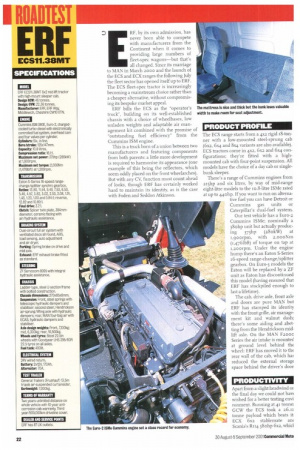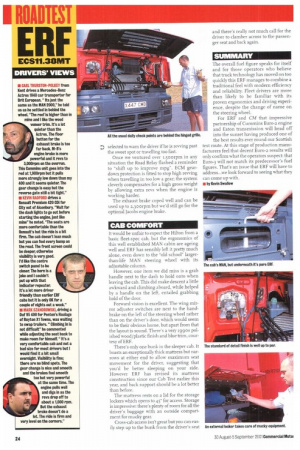ERF ECS11.38MT
Page 20

Page 22

Page 23

Page 24

If you've noticed an error in this article please click here to report it so we can fix it.
IPRICE AS TESTED: 262,171 (ex-VAT)*. ENGINE: 10.8 litres, 375hp (280kW). PAYLOAD: 26.11 tonnes. AVERAGE SPEED: 73.2km/h. AVERAGE FUEL CONSUMPTION: 8.43mpg.
*Includes £56,800 for basic vehicle; 22,065 for adjustable air management kit; £626 for Road Relay 3; £1,121 for sliding fifth wheel; £180 for lead-up ramps; £120 for hoses and couplings; £356 for catwalk step and grab handle; 1570 for three-piece plastic rear wings; £43 for hook-up lamp: £2S3 for cab painting in non-standard colours; and 127 for number plates.
Since MAN took over ERF the bespoke specialist has had access to many of its new parent's components, including the well-established F2000 cab. Operators may be disappointed to see
that the `ERF look' has been diluted, but the Euro-2 ECS fleet tractor has class-leading fuel consumption, so operators should be as satisfied as their drivers.
RF, by its own admission, has never been able to compete with manufacturers from the Continent when it comes to providing large numbers of fleet-spec wagons—but that's all changed. Since its marriage to MAN in March 2000 and the launch of the ECS and ECX ranges the following July the fleet sector has opened itself up to ERE. The ECS fleet-spec tractor is increasingly becoming a mainstream choice rather than a cheaper alternative, without compromising its bespoke market appeal.
ERF bills the ECS as the "operator's truck", building on its well-established chassis with a choice of wheelbases, low unladen weights and adaptable air management kit combined with the promise of "outstanding fuel efficiency" from the Cummins ISM engine.
This is a truck born of a union between two manufacturers and featuring components from both parents: a little more development is required to harmonise its appearance (one example of this being the reflectors, which seem oddly placed on the front wheelarches). But with any CV, function must count ahead of looks, though ERF has certainly worked hard to maintain its identity, as is the case with Foden and Seddon Atkinson.
PRODUCT PROFILE
The ECS range starts from a 4x2 rigid TS-tonner with a low-mounted steel-sprung cab (6x2, 6x4 and 8x4 variants are also available). ECS tractors come in 4x2, 6x2 and 624 configurations; they're fitted with a high. mountedcab with four-point suspension. All models have the choice of a day cab or singlebunk sleeper.
There's a range of Cummins engines from 215hp and six litres, by way of mid-range eight-litre models to the to.8-litre ISMe rated at up to ohp. If you want to run on alternative fuel you can have Detroit or Cummins gas units or Caterpillar's dual-fuel system.
Our test vehicle has a Euro-2 Cummins ISMe; nominally a 38ohp unit but actually producing 375hp (28okW) at 1,900rpm, with 2,000Nm (1,4761bft) of torque on tap at t,2oorpm. Under the engine hump there's an Eaton S-Series i6-speed range-change/splitter gearbox. On Euro-3 models the Eaton will be replaced by a ZF unit as Eaton has discontinued this model (having ensured that ERE has stockpiled enough to last a lifetime).
The cab, drive axle, front axle and doors are pure MAN but ERF has stamped its identity with the front grille, air management kit and walnut dash; there's some aiding and abetting from the Hendrickson mid. lift axle. On the MAN F200c Series the air intake is mounted at ground level behind the wheel: ERE has moved it to the rear wall of the cab, which has reduced the external storage space behind the driver's door
PRODUCTIVITY
Apart from a slight headwind or the final day we could not haw wished for a better testing envi ronment. Running at 41 tonne: GCW the ECS took a 26.11 tonne payload which beats it: ECX 6x2 stablemate ant Scania's RtLi. 38ohp 6x2, whicl
had a payload potential of 25.88 and 25.51 tonnes respectively. The engine in our test vehicle had already racked up 18,000 miles, SO it was well run in, and the overall consumption of 8.43mpg from this 6x2 375hp tractor sets a Euro-2 record that is unlikely to be beaten, with Euro-3 only weeks away.
It's a shame that this excellent figure was not achieved with more selling time in hand, but the ECS rightly deserves its moment of glory; we really can't begrudge it the steerpattern tyres on its drive axle which must have done their bit for fuel consumption.
On the first day of our three-day Scottish rest route, travelling up the M6 to Gretna areen, we clocked up 9.38mpg; on day two Are recorded an impressive 8.48mpg. But the ERF also shone over our "severe gradients" ;ection, where its 5.7impg eclipses even the ERE ECX 4o5's figure of 5.54mpg.
The "easy A-Roads" figure of 8.5mpg is on 1. par with slightly more powerful competiors like the Seddon Atkinson Strato 4o5hp 8.76mpg), ECX 4o5hp (9.6mpg) and Iveco EuroStar 43o Cursor (9.52mpg), all running at 41 tonnes. On the tough motorway section the ECS clocked up 8.56mpg to surpass the ECX's 7.96mpg, but it couldn't match the MAN 26.414's 8.67mpg (these figures were also achieved at 41 tonnes).
ON THE ROAD
Even if a fleet truck has a regular pilot, it's bound to spend some time in the hands of agency drivers with varying levels of experience. To counter this the fleet operator needs a functional truck that is easy to operate and easy to look after (as well as being productive and tough as old boots).
The ECS scores highly here. It feels more stable than a state-of-the-art mega-cab because there is very little roll on the cab. This tends to inspire confidence when negotiating corners and roundabouts and increases the sense of driveability.
With 375hp under its cab the ECS predictably loses ground to more powerful trucks
on the open road. We followed a much more powerful competitor around the Scottish test route and only lost a little time on the dual carriageways and motorways, but over the A68 section with its endless hills the difference was more noticeable.
The Eaton four-over-four 16-speed gearbox is probably the easiest type to handle. The throw is short, pre-selection is easy and practically all drivers will be familiar with its workings—another plus for a fleet machine. Full gear changes are best made at 1,5oo1,6 oorpm on the flat with half gears taken at around the 1,3oorpm mark. On a steady hill climb we took the split at slightly higher revs to maintain momentum, but the engine lugs well from just above L000rpm.
On sharper climbs when resorting to the lower half of the box the green band has to be ignored. On the A68 we dropped down to 3H several times; we lugged our 41 tonnes over Castleside with just enough to spare.
Traction with a 6x2 can be a problem on hills because of the lack of weight through the drive axle. The ECS's non-reactive, four-bag suspension compensated effectively to ensure that we left no rubber on the road when making those precarious changes into low range. But to aid hill starts the accelerator in our test truck was restricted to 1,400rprn when stationary...just in case.
Cruise control is only available on the Cummins diesel engine. There's a main CR switch on the dash with a setting switch and memory; it's easy to operate and intercedes comfortably. Our test truck also came with RoadRelay 3, which offers an instantaneous or average reading of mpg but can also be pre
selected to warn the driver if he is revving past the sweet spot or travelling too fast.
Once we ventured over 1,500rpm in any situation the Road Relay flashed a reminder to "shift up to improve mpg". ECM geardown protection is fitted to stop high revving when travelling in too low a gear; the system cleverly compensates for a high gross weight by allowing extra revs when the engine is working harder.
The exhaust brake coped well and can be used up to 2,300rpm but we'd still go for the optional Jacobs engine brake.
CAB COMFORT
It would be unfair to expect the Hilton from a basic fleet-spec cab, but the ergonomics of this well established MAN cabin are ageing well and ERF has sensibly left it pretty much alone, even down to the "old school" largerthan-life MAN steering wheel with its adjustable column.
However, one item we did miss is a grab handle next to the dash to hold onto when leaving the cab. This did make descent a little awkward and climbing aboard, while helped by a handle on the left, entailed grabbing hold of the door.
Forward vision is excellent. The wing mirror adjuster switches are next to the handbrake on the left of the steering wheel rather than on the driver's door, which would seem to be their obvious home, but apart from that the layout is sound. There's a very 1990s polished wood/plastic finish and blue trim, courtesy of ERF.
There's only one bunk in the sleeper cab. It boasts an exceptionally thick mattress but narrows at either end to allow maximum seat movement for the driver, suggesting that you'd be better sleeping on your side. However ERF has revised its mattress construction since our Cab Test earlier this year, and back support should be a lot better than before.
The mattress rests on a lid for the storage lockers which opens to 450 for access. Storage is impressive: there's plenty of room for all the driver's baggage with an outside compartment for mucky gear.
Cross-cab access isn't great but you can easily step up to the bunk from the driver's seat and there's really not much call for the driver to clamber across to the passenger seat and back again.
SUMMARY
The overall fuel figure speaks for itself and for those operators who believe that truck technology has moved on too quickly this ERF manages to combine a traditional feel with modern efficiency and reliability. Fleet drivers are more than likely to be familiar with its proven ergonomics and driving experience, despite the change of name on the steering wheel.
For ERF and CM that impressive partnership of Cummins Euro-2 engine and Eaton transmission will head off into the sunset having produced one of the best results ever round our Scottish test route. At this stage of production manufacturers feel that decent Euro-2 results will only confirm what the operators suspect: that Euro-3 will not match its predecessor's fuel figures. That's an issue that ERF will have to address.. we look forward to seeing what they can come up with.
• by Kevin Swallow




















































































































